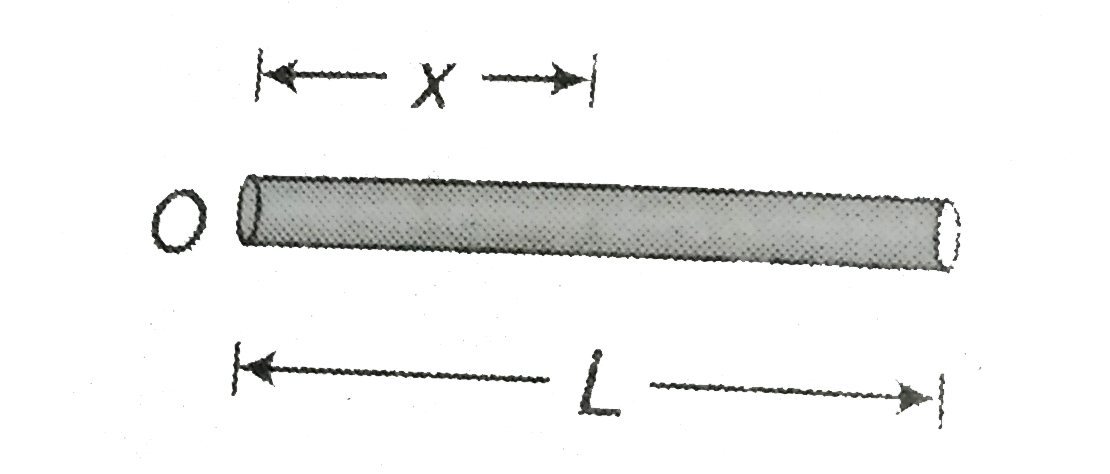The density of a linear rod of length L varies as ρ = A+Bx, where x is the distance from the left end. Locate the centre of mass.Solution in Bengali
The correct Answer is:xcm=3AL+2BL23(2A+BL)
Step by step video, text & image solution for The density of a linear rod of length L varies as rho = A+Bx, where x is the distance from the left end. Locate the centre of mass. by Physics experts to help you in doubts & scoring excellent marks in Class 11 exams.
Topper's Solved these Questions
- BOOK - CHHAYA PUBLICATIONCHAPTER - STATICSEXERCISE - Problem Set -II (Based on Equilibrium of Force )1videos
STATICS
- BOOK - CHHAYA PUBLICATIONCHAPTER - STATICSEXERCISE - Problem Set -II (Based on Equilibrium of Body )5videos
STATICS
- BOOK - CHHAYA PUBLICATIONCHAPTER - STATICSEXERCISE - Problem Set -I (Based on Centre of Gravity )2videos
STATICS
- BOOK - CHHAYA PUBLICATIONCHAPTER - SIMPLE HARMONIC MOTIONEXERCISE - CBSE SCANNER16videos
SIMPLE HARMONIC MOTION
- BOOK - CHHAYA PUBLICATIONCHAPTER - SUPERPOSITION OF WAVESEXERCISE - CBSE Scanner14videos
SUPERPOSITION OF WAVES
Similar Questions
Five masses 1 g, 2 g, 3 g, 4 g, and 5 g are suspended serially at a separation of 25 cm from a weightless metre rod. Where should the rod the be supported so that it remains horizontal?
06:03View SolutionTo lift a motor car from a ditch, one end of a rope ABC is attached to a point A of a tree and the other end is tied at a point C of the car. At the mid-point B of the rope ,a pull of 200 kg -wt is applied at right angles to AC. If ∠ABC=120∘ , find the tension in the rope.
05:18View SolutionA uniform straight rod mass 50 kg and length 4 m is to be supported on two supports equidistant from the respective ends. What can be the maximum distance of the supports so that a 30 kg counterpoising weight can be kept in equilibrium at any point on the rod?
03:34View SolutionExplain the relation in phase between displacement velocity and acceleration in SHM, graphically as well as theoretically.
04:46View SolutionA progressive wave is given by y(x,l)=Bcos(300t−0.15x) where x and y are in cm and t in second . What is the (i) direction of propagation, (ii) wavelength , (iii) frequency, (iv) wave speed and (v) phase difference between two points 0 . 2 m apart ?
09:18View SolutionThe density of a linear rod of length L varies as ρ=A+Bx where x is the distance from the left end. Locate the centre of mass.
 02:54View Solution
02:54View SolutionA rod of length L is placed along the x-axis between x=0 and x=L . The linear mass density (mass/length) rho of the rod varies with the distance x from the origin as rho=a+bx . Here, a and b are constants. Find the position of centre of mass of this rod.
07:00View SolutionIf the linear density (mass per unit length) of a rod of length 3m is proportional to x, where x, where x is the distance from one end of the rod, the distance of the centre of gravity of the rod from this end is.
04:10View SolutionThe linear mass density i.e. mass per unit length of a rod of length L is given by ρ=ρ0(1+xL), where ρ0 is constant , x distance from the left end. Find the total mass of rod and locate c.m. from the left end.
 03:02View Solution
03:02View Solutionएक छड़ के पदार्थ का घनत्व ρ=A+Bx के अनुसार बदलता है , जहाँ A,B अचर है तथा x, छड़ में बाएँ किनारे से दूरी है | छड़ कि दूरी लम्बाई L है | इसके द्रव्यमान केंद्र कि स्थिति ज्ञात करें |
 04:26View Solution
04:26View SolutionL लम्बाई की रेखीय छड़ का घनत्व ρ=Bx से बदलता है जहां x बाएं सिरे से दूरी है। छड़ का द्रव्यमान केंद्र है
View SolutionIf L is the linear density of the length rod. lamda = A + Bx Calculate the position of the center of mass. (Where x is the distance from one end)
View SolutionA rod of length L is placed along the X-axis between x=0andx=L. The linear density (mass/length) ρ of the rod varies with the distance x from the origin as ρ=a+bx. a.) Find the SI units of a and b b.) Find the mass of the rod in terms of a,b, and L.
View SolutionThe density of a rod of length L varies as ρ=A+Bx where x is the distance from the left end. Locate the centre of mass.
 03:47View Solution
03:47View SolutionIf the linear density of a rod of length L varies as lambda = (kx^(2))/(L) where k is a constant and x is the distance of any point from one end, then find the distance of centre of mass from the end at x = 0.
04:16View Solution

